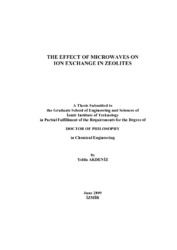Please use this identifier to cite or link to this item:
https://hdl.handle.net/11147/3003Full metadata record
| DC Field | Value | Language |
|---|---|---|
| dc.contributor.advisor | Ülkü, Semra | en |
| dc.contributor.author | Akdeniz, Yelda | - |
| dc.date.accessioned | 2014-07-22T13:48:44Z | - |
| dc.date.available | 2014-07-22T13:48:44Z | - |
| dc.date.issued | 2009 | en |
| dc.identifier.uri | http://hdl.handle.net/11147/3003 | - |
| dc.description | Thesis (Doctoral)--Izmir Institute of Technology, Chemical Engineering, Izmir, 2009 | en |
| dc.description | Includes bibliographical references (leaves: 135-143) | en |
| dc.description | Text in English; Abstract: Turkish and English | en |
| dc.description | xvi, 220 leaves | en |
| dc.description.abstract | Recent innovations of microwave field lead many scientists to focus on this phenomenon and it has been begun to be applied in different fields of zeolite applications. The purpose of this study is to determine the effect of microwave irradiation on ion exchange degree and on the structure of natural zeolite. The clinoptilolite rich mineral from Western Anatolia was used throughout the experiments. The ion exchange experiments were performed using AgNO3, Co.(NO3)26H2O and Cu (NO3)25/2H2O within 0.01M - 1M and 40 oC - 80 oC concentration and temperature range in conventional waterbath and microwave. Different solid and solution conditions on ion exchange degree were determined, as well. Metal exchanged minerals were characterized by using instrumental techniques. Antibacterial activity of the Agexchanged clinoptilolite against E. coli was determined by Kirby.Bauer method. The Ag +, Co2+ and Cu2+ amounts within the mineral increased with decreasing S/L while increased with increasing temperature and time. For some utilized parameters microwave treatment was effective however on the whole it did not significantly improved the degree of ion exchange compared to waterbath treatment. The inspection of XRD patterns and FTIR spectra of metal exchanged minerals confirmed that no transition of clinoptilolite phase and no shifts in peak positions occurred with exchange methods applied. The sorption processes are controlled mainly by external-phase mass transfer. Ag+, Co2+ and Cu2+ sorptions on NaCLI exhibited a good fit to Freundlich model and Langmuir models. All metal exchanged minerals showed considerable superiority against E.Coli. | en |
| dc.language.iso | en | en_US |
| dc.publisher | Izmir Institute of Technology | en |
| dc.rights | info:eu-repo/semantics/openAccess | en_US |
| dc.subject.lcc | TP156.I6 .A313 2009 | en |
| dc.subject.lcsh | Ion exchange | en |
| dc.subject.lcsh | Zeolites--Absorption and adsorption | en |
| dc.subject.lcsh | Microwaves | en |
| dc.title | The effect of microwaves on ion exchange in zeolites | en_US |
| dc.type | Doctoral Thesis | en_US |
| dc.institutionauthor | Akdeniz, Yelda | - |
| dc.department | Thesis (Doctoral)--İzmir Institute of Technology, Chemical Engineering | en_US |
| dc.relation.publicationcategory | Tez | en_US |
| item.openairecristype | http://purl.org/coar/resource_type/c_18cf | - |
| item.grantfulltext | open | - |
| item.cerifentitytype | Publications | - |
| item.fulltext | With Fulltext | - |
| item.openairetype | Doctoral Thesis | - |
| item.languageiso639-1 | en | - |
| Appears in Collections: | Phd Degree / Doktora | |
Files in This Item:
| File | Description | Size | Format | |
|---|---|---|---|---|
| T000078.pdf | DoctoralThesis | 7.88 MB | Adobe PDF |  View/Open |
CORE Recommender
Page view(s)
140
checked on Nov 18, 2024
Download(s)
72
checked on Nov 18, 2024
Google ScholarTM
Check
Items in GCRIS Repository are protected by copyright, with all rights reserved, unless otherwise indicated.